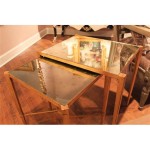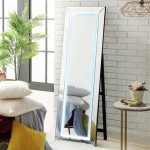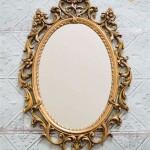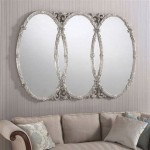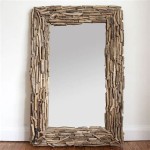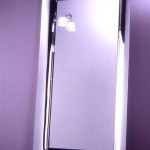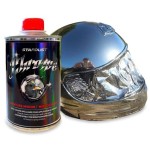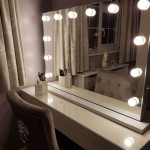How To Glue A Frame To A Mirror
Attaching a frame to a mirror requires precision and the right materials to ensure a strong, lasting bond and a professional finish. This guide provides a comprehensive overview of the process, outlining the necessary steps and precautions.
Preparing the Mirror and Frame
Proper preparation is crucial for successful adhesion. This involves cleaning both surfaces and ensuring compatibility between materials.
- Clean the mirror's edges: Use a glass cleaner specifically designed for mirrors to remove any dust, dirt, or fingerprints. Ensure the edges where the frame will contact are thoroughly cleaned.
- Clean the frame's rabbet: The rabbet is the recessed area on the back of the frame where the mirror sits. Clean it with a damp cloth to remove any dust or debris. For wooden frames, lightly sanding the rabbet can improve adhesion.
- Check for fit: Ensure the mirror fits snugly within the frame's rabbet. A tight fit provides better support and reduces the risk of the mirror shifting during gluing.
- Protect the mirror surface: Cover the mirror's reflective surface with masking tape or paper to shield it from glue spills and scratches during the framing process. Leave the edges exposed where the frame will attach.
Choosing the Right Adhesive
Selecting the correct adhesive is paramount for a secure and durable bond. Different adhesives are suited for different materials and applications.
- Neutral cure silicone sealant: This is a popular choice for framing mirrors due to its strong bonding capabilities, flexibility, and resistance to moisture. It's suitable for most frame and mirror materials.
- Mirror mastic: Specifically formulated for adhering mirrors to various surfaces, mirror mastic provides a strong, permanent bond. However, it can be more difficult to work with than silicone sealant.
- Construction adhesive: While suitable for some applications, construction adhesives may not be ideal for all mirror and frame materials. It's crucial to check compatibility before use.
- Consider environmental factors: For bathrooms or areas with high humidity, choose an adhesive with excellent moisture resistance to prevent the bond from weakening over time.
Applying the Adhesive
The application process requires care and precision to ensure an even distribution of adhesive and a secure bond.
- Use a caulking gun: For silicone sealant and mirror mastic, a caulking gun provides controlled and even application. Cut the nozzle tip at a 45-degree angle for optimal flow.
- Apply beads of adhesive: Apply continuous beads of adhesive along the inside edges of the frame's rabbet. The beads should be sized appropriately to provide sufficient coverage without excessive squeeze-out.
- Spacing of adhesive beads: For larger mirrors, consider applying multiple beads of adhesive, spaced evenly, to ensure adequate coverage across the entire contact area.
Setting the Mirror in the Frame
Once the adhesive is applied, carefully position the mirror within the frame and secure it in place.
- Careful placement: Gently lower the mirror onto the adhesive beads within the frame's rabbet, ensuring it's aligned correctly. Avoid sliding the mirror once it's in contact with the adhesive.
- Apply even pressure: Apply gentle, even pressure to the back of the mirror to ensure full contact with the adhesive. Avoid excessive force, which could crack the mirror.
- Secure with clamps or tape: Use mirror clips, clamps, or strong tape to secure the mirror in place while the adhesive cures. This prevents shifting and ensures a tight bond.
Curing and Finishing
Allowing adequate curing time is essential for achieving maximum bond strength. Follow the adhesive manufacturer's instructions for specific curing times.
- Curing time: Most adhesives require 24 to 72 hours to fully cure. Avoid disturbing the mirror during this period.
- Remove clamps or tape: Once the adhesive is fully cured, carefully remove any clamps or tape used to secure the mirror.
- Clean up excess adhesive: Carefully remove any excess adhesive that has squeezed out from between the frame and the mirror using a razor blade or a specialized adhesive remover. Be cautious not to scratch the mirror or frame.
- Final inspection: Inspect the framed mirror for any gaps or imperfections. If necessary, apply additional adhesive to address any gaps and ensure a seamless finish.
Safety Precautions
Working with adhesives requires taking necessary safety precautions to avoid injury and ensure proper handling of materials.
- Ventilation: Work in a well-ventilated area to avoid inhaling fumes from adhesives. Wear a respirator if necessary.
- Gloves: Wear protective gloves to prevent skin contact with adhesives.
- Eye protection: Wear safety glasses or goggles to protect your eyes from splashes or fumes.
- Disposal: Dispose of used adhesive cartridges and other materials according to local regulations.

Diy Stick On Mirror Frame Sawdust Sisters

Diy Bathroom Mirror Frame For Under 10 O Hayley Blog

Mirror Frame Diy How To Update A Basic Bathroom Our Faux Farmhouse

Diy Bathroom Mirror Frame Without Removing Clips Her Happy Home

Diy Hot Glue Decorative Framed Mirror Shabby Chic

How To Frame A Mirror Sand And Sisal

Easiest Way To Frame A Mirror House Mix

Diy Stick On Mirror Frame Sawdust Sisters

Mirror Frame Diy How To Update A Basic Bathroom Our Faux Farmhouse

How To Frame A Mirror

